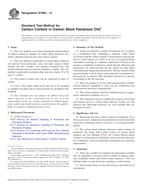Wir benötigen Ihre Einwilligung zur Verwendung der einzelnen Daten, damit Sie unter anderem Informationen zu Ihren Interessen einsehen können. Klicken Sie auf "OK", um Ihre Zustimmung zu erteilen.
ASTM D6450-12e1
Standard Test Method for Flash Point by Continuously Closed Cup (CCCFP) Tester (Includes all amendments And changes 7/6/2016).
Automatische name übersetzung:
Standardtestverfahren für Flammpunkt von Kontinuierlich Closed Cup (CCCFP) Tester
NORM herausgegeben am 1.12.2012
Informationen über die Norm:
Bezeichnung normen: ASTM D6450-12e1
Anmerkung: UNGÜLTIG
Ausgabedatum normen: 1.12.2012
SKU: NS-35188
Zahl der Seiten: 7
Gewicht ca.: 21 g (0.05 Pfund)
Land: Amerikanische technische Norm
Kategorie: Technische Normen ASTM
Kategorie - ähnliche Normen:
Die Annotation des Normtextes ASTM D6450-12e1 :
Keywords:
continuously closed cup, flammability, flash point, ICS Number Code 75.080 (Petroleum products in general)
Ergänzende Informationen
| Significance and Use | ||||||||||||||
|
5.1 The flash point temperature is one measure of the tendency of the test specimen to form a flammable mixture with air under controlled laboratory conditions. It is only one of a number of properties that must be considered in assessing the overall flammability hazard of a material. 5.2 Flash point is used in shipping and safety regulations to define flammable and combustible materials and classify them. This definition may vary from regulation to regulation. Consult the particular regulation involved for precise definitions of these classifications. 5.3 This test method can be used to measure and describe the properties of materials in response to heat and an ignition source under controlled laboratory conditions and shall not be used to describe or appraise the fire hazard or fire risk of materials under actual fire conditions. However, results of this test method may be used as elements of a fire risk assessment, which takes into account all of the factors that are pertinent to an assessment of the fire hazard of a particular end use. 5.4 Flash point can also indicate the possible presence of highly volatile and flammable materials in a relatively nonvolatile or nonflammable material, such as the contamination of lubricating oils by small amounts of diesel fuel or gasoline. |
||||||||||||||
| 1. Scope | ||||||||||||||
|
1.1 This flash point test method is a dynamic method and depends on definite rates of temperature increase. It is one of the many flash point test methods available, and every flash point test method, including this one, is an empirical method. 1.2 This test method covers the
determination of the flash point of fuel oils, lube oils, solvents,
and other liquids by a continuously closed cup tester. The
measurement is made on a test specimen of 1 mL.
1.3 This test method utilizes a closed but unsealed cup with air injected into the test chamber. 1.4 This test method is suitable for testing samples with a flash point from 10 to 250°C. 1.5 If the user's specification
requires a defined flash point method other than this test method,
neither this test method nor any other method should be substituted
for the prescribed method without obtaining comparative data and an
agreement from the specifier.
1.6 The values stated in SI units are to be regarded as standard. No other units of measurement are included in this standard. Temperatures are in degrees Celsius, and pressure is in kilo-pascals. 1.7 This standard does not
purport to address all of the safety concerns, if any, associated
with its use. It is the responsibility of the user of this standard
to establish appropriate safety and health practices and determine
the applicability of regulatory limitations prior to use.
Standard Practice for Determination of
Precision and Bias Data for Use in Test Methods for Petroleum
Products, Liquid Fuels, and Lubricants Standard Practice for Sampling Industrial
Chemicals ISO Guide 34 Standard Practice for Manual Sampling of
Petroleum and Petroleum Products Standard Practice for Automatic Sampling
of Petroleum and Petroleum Products (Includes all amendments and
changes 3/24/2023). ISO Guide 35 Reference materialsGeneral and
statistical principles for certification Standard Practice for Applying
Statistical Quality Assurance and Control Charting Techniques to
Evaluate Analytical Measurement System Performance (Includes all
amendments and changes 12/12/2023). |
Ähnliche Normen:
Historisch
15.2.2010
Historisch
1.11.2013
Historisch
1.11.2013
Historisch
15.2.2011
Historisch
1.6.2012
Historisch
1.5.2013
Empfehlungen:
Aktualisierung der technischen Normen
Wollen Sie sich sicher sein, dass Sie nur die gültigen technischen Normen verwenden?
Wir bieten Ihnen eine Lösung, die Ihnen eine Monatsübersicht über die Aktualität der von Ihnen angewandten Normen sicher stellt.
Brauchen Sie mehr Informationen? Sehen Sie sich diese Seite an.



 ASTM D7578-10e1
ASTM D7578-10e1 ASTM D7662-13
ASTM D7662-13 ASTM D7679-13
ASTM D7679-13 ASTM D7683-11
ASTM D7683-11 ASTM D7776-12
ASTM D7776-12 ASTM D7777-13
ASTM D7777-13
 Cookies
Cookies
